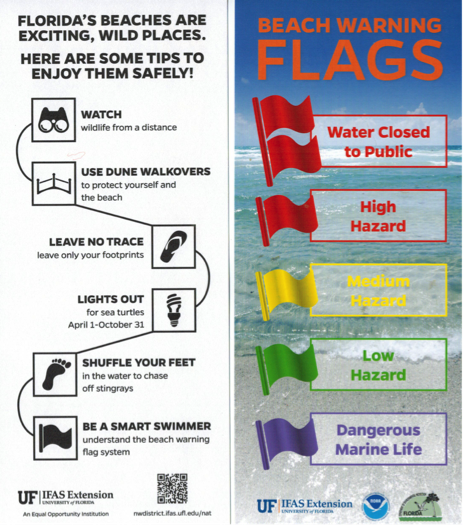
Pregnant Bull Shark (Carcharhinus leucas) cruses the sandy seafloor. Credit Florida Sea Grant Stock Photo
Shark Safety Tips
UF/IFAS Extension – Florida Sea Grant
By L. Scott Jackson (Bay County) and Rick O’Connor (Escambia County)
Recently, two teens were victims of unusual shark attacks in North Carolina. The two attacks occurred within minutes and miles of each other. A similar incident happened in the Florida Panhandle in 2005. One teen lost her life and one lost his leg. The attacks were within days of each other and the distance between the two attacks was less than 100 miles. Experts identified Bull Sharks as being responsible for both Panhandle shark encounters.
Bull Sharks migrate north as ocean waters of the Gulf and Atlantic warm. As the nearshore environment cools in the late fall and winter, Bull Sharks follow the receding warm water and eventually move out of the local area. Bull Sharks are an aggressive shark responsible for a reported 100 attacks on humans resulting in 21 fatalities. (Reported from 1580 to 2014 Source: International Shark Attack Files).
Experts suggest Bull Sharks may be responsible for many shark attacks where the species is unknown or not identified.
Overall, the number of shark encounters is slowly trending higher as more people swim and participate in other water related activities. However, negative encounters with sharks remain a rare occurrence. In 2014, Florida reported 28 shark bites with no fatalities. On average, only one shark attack fatality is reported every other year in the United States. The risk of shark attack is very low compared to other potential recreational hazards. For example, in 2014, 26 people died as a result of lightning strikes in the United States, with six of those being in Florida.
George Burgess with the International Shark Attack File has compiled a list of action strategies you can use to reduce the chances of a negative encounter with a shark:
Keep these tips in mind the next time you hit the beach!
- Avoid being in the water from sunset to sunrise. This is when sharks are most active and have a competitive sensory advantage.
- Stay in a group, and do not wander too far from shore. Isolated individuals are more likely to be attacked than large groups; in addition, the farther you are from shore, the farther you are from help.
- Consider your clothing: avoid wearing shiny jewelry, because the reflected light resembles the sheen of fish scales.
- Avoid brightly colored or patterned clothing, because sharks see contrast particularly well.
- Do not enter waters being used by sport or commercial fisherman – sharks can sense the smells emitted from bait at incredible distances.
- Avoid entering waters with sewage output and/or entering the water if you are bleeding. Such additions to the water can act as strong olfactory attractants to sharks.
- Know your facts! Porpoise sightings do not indicate the absence of sharks. In fact, the opposite is often true. Also be on the lookout for signs of baitfish or feeding activity – diving seabirds are good indicators of such action. Animals that eat the same food items are often found in close proximity. Remember, a predator is never too far from its prey.
- Refrain from excess splashing while in the water, and do not allow pets in the water because of their erratic movements.
- Exercise caution when occupying the area between sandbars or near steep drop-offs, as these are favorite hangouts for sharks.
- Do not enter the water if sharks are known to be present, and evacuate the water if sharks are seen while there. And, of course, do not harass a shark if you see one!
- Stay calm if you do see a shark, and maintain your position in as quiet a manner as possible. Most sharks merely are curious and will leave on their own.
- Relax! You are more likely to be injured by lightning than attacked by a shark. To learn more about your relative risks, see: The Relative Risk of Shark Attacks to Humans
Our beautiful Emerald Coast is an alluring wild habitat. Simply put – Swimming at the beach is not the same as swimming in a backyard pool. Have fun at the beach but be mindful and respectful of potential hazards. Knowing what to do to be safe will actually help you enjoy time at the beach while keeping worry and concern at a minimum.

Follow these beach safety tips for helping your family enjoy the beach while protecting coastal wildlife.
- Stem to Stern (Northwest Florida November 2, 2023) - March 28, 2024
- Gearing up for Red Snapper - July 21, 2023
- ¡Conviértase un cuidador de las vieiras (“Scallop Sitter”)! - October 7, 2022
